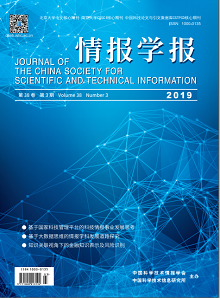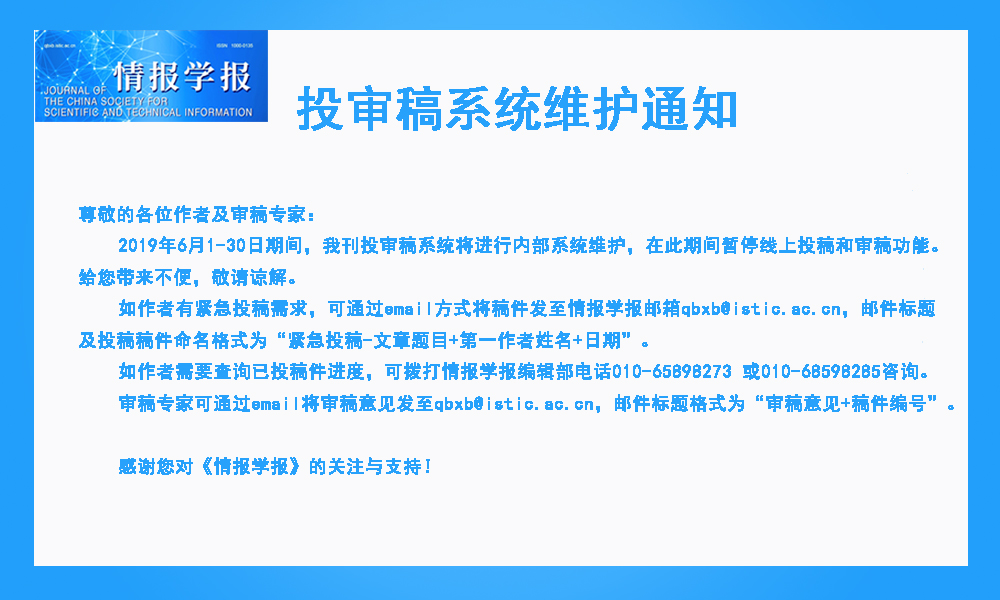 |
|
2019 Vol. 38, No. 3
Published: 2019-03-28 |
|
|
| |
|
|
|
|
|
227 |
Reflection on the Development of the Scientific and Technical Information Industry Based on the National Science and Technology Management Platform Hot! |
|
 |
Zeng Jianxun |
|
|
DOI: 10.3772/j.issn.1000-0135.2019.03.001 |
|
|
The Ministry of Science and Technology is leading the construction of a national science and technology management platform. How to seize this opportunity to make the platform an important part of the scientific and technological information business, with a view to promoting the development of the scientific and technical information industry by integrating it into the innovation system, has become a problem that needs to be solved urgently. This paper reviews the original intention and development course of the scientific and technical information industry and analyzes the current difficulties and challenges. Then, considering the construction of the national science and technology management platform, the feasibility of integrating the scientific and technological information business into scientific and technological management is analyzed. The paper then analyzes the new opportunities brought forth by the construction of the national science and technology platform for relieving the difficulties faced by the scientific and technical information industry. This analysis is done from the perspective of building a new system of science and technology information network or station, reshaping the core intelligence user groups, realizing the accumulation of original scientific research data, and building a collaborative service platform for scientific research information. Finally, the paper proposes an overall framework for the scientific and technical information industry, oriented towards the implementation of the science and technology plan, a model for integrating science and technology information service into the science and technology management platform, and a strategy for promoting the scientific and technical information industry based on the national science and technology management platform. |
|
|
2019 Vol. 38 (3): 227-238
[Abstract]
(
432
)
HTML
(92 KB)
PDF
(1480 KB)
(
1502
) |
|
|
|
239 |
Research on the Development Path of Intelligence Studies Based on Big Data Thinking Hot! |
|
 |
Pin Li, Jianlin Yang |
|
|
DOI: 10.3772/j.issn.1000-0135.2019.03.002 |
|
|
Discipline construction has been a major concern in academic circles. The big data environment has pushed intelligence studies into a new developmental stage. Although it has brought about a great crisis for intelligence studies, it has also brought great opportunities for as well as the promotion of intelligence studies and the cohesion of research resources. This paper argues that the core of cracking the crisis and grasping the opportunity lies in big data thinking in the discipline construction of intelligence studies. Accordingly, big data thinking is considered a guide, and this article rethinks the discipline orientation, discipline objectives, theoretical systems, knowledge systems, and production management systems of intelligence studies, as well as intelligence research, information services, and intelligence personnel training. |
|
|
2019 Vol. 38 (3): 239-248
[Abstract]
(
308
)
HTML
(114 KB)
PDF
(813 KB)
(
1269
) |
|
|
|
249 |
Semantic Recognition and Classification Method of Innovation Points in Scientific and Technological Abstracts Hot! |
|
 |
Wen Hao |
|
|
DOI: 10.3772/j.issn.1000-0135.2019.03.003 |
|
|
The published scientific and technical abstracts provide reliable semantic fact data of problems, methods, and results in scientific research activities, and lay a solid foundation for the dissemination of innovative points and the discovery of new interdisciplinary knowledge. Their accurate identification and separation will be a key issue in the use of artificial intelligence technology to realize an innovative factual knowledge question and answer system. This paper proposes an innovative point semantic recognition and classification method. On this method, scientific and technological abstracts are firstly classified as 6 kinds according to their syntactic and semantic functions. Secondly, the results of the classification are analyzed with statistical analysis of the number distribution of classes and sentence positions, sentence types and the structural features of sentence semantic positions, and the semantic word order characteristics of abstract sentences are tested. Finally, the second classification and merging are carried out which is based on the previous analysis, so and the classification of the innovation points, methods and results of scientific and technological abstracts is realized. The accuracy rate of classification is 99%. The experimental results show that this method has the advantages of simple algorithm, high classification accuracy, and good universality. |
|
|
2019 Vol. 38 (3): 249-256
[Abstract]
(
258
)
HTML
(100 KB)
PDF
(764 KB)
(
1159
) |
|
|
|
257 |
Research on User Information Sharing Behavior of Social Network Based on Regulatory Focus Theory Hot! |
|
 |
Zhu Peng, Li Lu, Gary Marchionini |
|
|
DOI: 10.3772/j.issn.1000-0135.2019.03.004 |
|
|
This paper uses privacy calculus theory and regulatory focus theory to study the information sharing behavior of social network users. It focuses on the impact of perceived risk and perceived benefit on user information sharing behavior, the impact of regulatory focus on perceived risk and perceived benefit, and the impact of their interaction on user information sharing behavior. This paper constructs a social network user information sharing behavior model based on regulatory focus theory. 376 valid samples are collected through questionnaires, and the hypothesis is verified by constructing a regression equation, a t test, and an analysis of variance. The results show that perceived risk negatively affects user information sharing behavior, while perceived benefit positively affects information sharing behavior, and the user s regulatory focus trait has a significant impact on the user's perceived benefit. Based on this conclusion, this paper puts forward reasonable suggestions for the development of social network platforms. |
|
|
2019 Vol. 38 (3): 257-265
[Abstract]
(
427
)
HTML
(138 KB)
PDF
(838 KB)
(
1129
) |
|
|
|
266 |
Assessment of Personal Information Value and Individual Differences Under the Situation of Information Leakage: An Empirical Study Based on Discrete Choice Experiment Hot! |
|
 |
Deng Shengli, Zhao Haiping |
|
|
DOI: 10.3772/j.issn.1000-0135.2019.03.005 |
|
|
In the era of big data, the collection of massive amounts of personal information provides value for both governments and enterprises, but also raises concerns about data security and the leakage of personal information. Based on the discrete choice model, this study analyzes the relationship between different types of personal information leakage and individualswillingness to accept the leak by designing experiments. This study quantitatively assesses the value of each type of information from the perspective of the user, and we classify the samples by gender, age, education, and frequency of Internet use. The results show that ① basic personal information has the highest value, whereas social network information has the lowest. ② The expected value of women for all types of personal information is generally higher than that of men. ③ Compared with 18-30-year-olds, people over the age of 40 are less concerned about Internet search information. ④ People with higher academic qualifications have a higher expected value for various types of personal information. ⑤ Compared with those with lower Internet usage frequency, people with high frequency of Internet usage pay more attention to shopping and payment information. This study illustrates a quantitative analysis method for assessing the value of personal information. The results will help the information-collection department understand the preferences of individualspersonal information and the adjustment of information-collection strategies. This work also provides reference for government departments to formulate personal information-protection policies. |
|
|
2019 Vol. 38 (3): 266-276
[Abstract]
(
326
)
HTML
(177 KB)
PDF
(979 KB)
(
1094
) |
|
|
|
286 |
Research on Financial Knowledge Representation and Risk Identification from Knowledge Connection Perspective Hot! |
|
 |
Tang Xuli, Ma Feicheng, Fu Weigang, Zhang Rui |
|
|
DOI: 10.3772/j.issn.1000-0135.2019.03.007 |
|
|
The limitations of financial risk analysis, such as homogeneous data source, simplistic data types, and one-sided research perspective, are attributed to insufficient representation of big data in finance; the traditional flat data organization ignores the rich knowledge connection among financial data. This paper explores the knowledge representation model of big data on financials from a knowledge organization perspective. It classifies the process of knowledge representation into three layers: knowledge representation mode, knowledge instance, and knowledge mining. First, the paper summarizes the typical connection patterns that exist in the financial domain, such as classification connection, spatial-temporal connection, statistical connection, and event connection, and categorizes these into static ontology, dynamic ontology, and social ontology according to the differential realization. Then, following the implementation of each ontology, it proposes related implementation schemes as well as the reuse of the existing ontology of Financial Industry Business Ontology (FIBO). Lastly, it demonstrates the representation process using the case of financial risk identification. |
|
|
2019 Vol. 38 (3): 286-298
[Abstract]
(
266
)
HTML
(117 KB)
PDF
(6393 KB)
(
1832
) |
|
|
|


